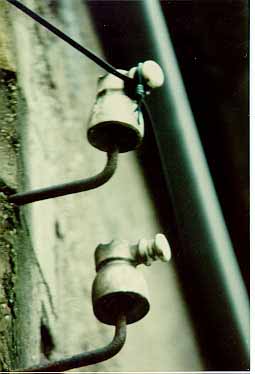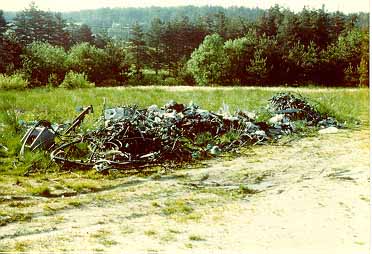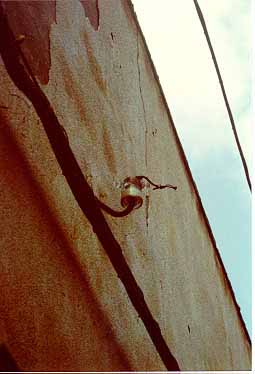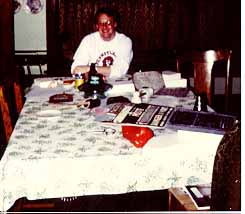
We left London on May 23 on a train bound for Newhaven. At Newhaven we boarded a ferry, and when it arrived at Dieppe, France, in the wee hours of the morning, we transferred to a train to Paris. I happened to wake up at the crack of dawn and caught sight of the sun rising over the beautiful French countryside and glittering on all the green glass sombreros along the railway. Truly a memorable sight.
Paris was much like London: very little open line construction, hence, few insulators.
eastern France. We saw several styles of insulators: CD 640s and 642s in a wide variety of green shades and a few 532, 535, 560, 611 or some other wide-skirt style, and various t-bar and noser styles. We also saw some porcelain: U-2057, 1423, along with spools, sombreros, and multipart power pieces in both porcelain and glass. We noticed most of the unused insulators are on the sides of houses and buildings, not on poles.
Near Strasbourg, though, the insulators seemed very German. This area of France has been under French and German governments for centuries, so the cultures tend to blend a bit. We saw some U-2285s and 1692s around the city, with a few CD 640s here and there.
 |
| Nosers |
|---|
At the other end of the alley were some CD 560 Isorexes in dark green, also cemented securely. We quickly found out this alley was the driveway to a parking lot, so, wanting to avoid jail, we settled for photos. Also in Nancy we saw some CD 666.2 nosers along with an exact replica in white porcelain, and some taller glass ones, maybe CD 667 or something even taller.
One afternoon we stopped in a small town named Chateau Salins for dinner and passed an abandoned depot with torn up tracks. Since the place simply demanded further investigation, we stopped at the supermarket, bought food, and had our picnic dinner at the depot, then went exploring. We found no whole insulators, but the search yielded a number of interesting pieces. In glass we found identifiable pieces of CD 642, 532, and also a big chunk of near-clear glass that must have been part of a large high-voltage piece. We also noticed some U-2057 pieces in white, and a strange crown piece in green porcelain. Two large shards proved most interesting: one is the rear skirt of a CD 642 embossed 35/1 and under this in large bold letters was embossed EST. Then Andy found a front piece lettered ISOREX in normal fashion, and under that in the large bold embossing was SNCF. He explained that this is an abbreviation for Societe Nationale de Chemin du fer Français, loosely translated as French National Railway Society. EST is the French word for east and most likely indicates the branch of the SNCF network.
The next day we drove out of France into Germany to visit Andy's relatives in Neckarsulm, Albert and Ursula Heyd. Their daughter, Susanne, and her husband of three weeks, Peter Lang, are our age (22) and speak English well, which helped a lot since Andy had only studied German for two years and I knew very little. They are all really wonderful people and we became friends immediately.
The next day Peter and Susanne noticed that we were gawking at some clear CD 600s. Naturally they were curious as to what we were talking about. It is never very easy trying to explain about insulators when there's no language barrier to contend with -- with one, it is nearly impossible!
A few days later we were given a tour of Gemmingen, a nearby town where Andy's great-grandfather lived before moving to America. On a few old houses in town we spotted a few U-1631s.
After dinner that evening at Ursula and Bert's home, Peter handed us a bag and said "Guess what?" We were completely surprised to find a pair of U-1692s with an incuse PB2 on the ear! The conversation turned to insulator collecting, with all the usual questions: "How many do you have? Where do you keep them all? Do a lot of Americans collect these things? People pay money for them? How much? Are you serious?!?"
A few days later we said good-bye to the Heyds (that wasn't easy) and headed north to Rothenburg. Walking around the city wall gave us a great view of several insulators, mostly brown U-2285s. We poked our head out one window and saw a really strange porcelain tramp with a green glazed crown. The one closest to us was a bit wiggly, but even after ten minutes of wiggling and pushing it still wouldn't come off the pin. We would have tried to saw through the pin, but the place was just too visible and the pin was more than an inch thick.
In Namur, Belgium, we saw various colored CD 459s and their porcelain twins, U-220s, and more French glass: CD 535, 536, and 537s and "cock's combs" of various sizes. A few houses down the street from our hostel an electrician was working on the service drop to a house, which was insulated with a 7-up green cock's comb, probably CD 656. Andy explained we were Americans who collect insulators and wondered if he had any old insulators he wanted to get rid of. He gruffly replied that he usually discarded insulators on the spot. We thanked him and as we walked away we noticed him smiling. Guess we gave him a laugh for the day.
We drove back into France and spotted a pile of old poles and caught a glimpse of aqua. We stopped to poke around. All we could find unbroken were small sombreros in greenish aqua and one CD 379.5 L'ELECTRO VERRE on a 2" pin. I started to hack through it, but a lady in a nearby house started getting curious and asking questions. After twenty minutes of sawing I was still only a quarter way through the pin, so we decided to leave it before any trouble started. At least I saved a sombrero and a few small red "Danger de Mort" signs.
On the way into Paris again, on a line of mostly 532s, there were several aqua CD 145 beehives! They were the same medium aqua as most Brookfields. Could Brookfield have sent insulators to France?
Although it was the greatest vacation I've ever had, and it was thrilling to see all the different glass and porcelain styles in Europe, I am still rather disappointed that I didn't bring some home with me. I kind of regret not being more daring in a few of those situations, but since it was my first time over there, I just wanted to avoid going to jail!
 |
| The Dump |
|---|
Another day I held Stéphane while he reached over a power station wall to get me a porcelain insulator similar to U-2034. Later on, he and Xavier took me back to a spot that I had been to 5 years ago -- the insulator dump I had visited on my first trip to France. At first sight, it appeared empty, but we stopped anyway. It had been bulldozed, and you could see pieces of insulators all over the place. Here and there, though, you could find a whole one. And then came my find. Five years ago I had stood there, found an insulator, picked it up, looked it over, and threw it back since it was broken. Now, five years later, and a bit wiser, I found a porcelain gingerbread man with the back skirt badly broken. It was the very same one I had thrown back 5 years ago -- a brown porcelain gingerbread mama! As if that wasn't enough, we also found a glass ISOREX 25/7 gingerbread mama, identical to the porcelain one, with no inner skirt.
 |
| T-Bar |
|---|
Walking back to St. Flour from the train station after coming back from Sicily, I saw two black gingerbread men. Serge Pichot said that he thought that the colored ones were from right after the war. I don't have any idea about the truth of that, but there aren't too many of the colored ones out there. The brown one I have and those two black ones were the only non-white gingerbread men, actually the only non-white porcelain, that I saw there.
 |
| The Loot |
|---|
The signs: ATTENTION WARNING LES CONDUCTEURS THE WIRES EN AMONT DES SECTIONNEURS ABOVE THE DISCONNECTORS RESTENT SOUS TENSION CARRY ELECTRICAL CURRENT DANGER DE MORT DANGER OF DEATH DEFENSE ABSOLUE IT IS STRICTLY FORBIDDEN DE TOUCHER AUX FILS TO TOUCH THE WIRES MÊME TOMBÉ À TERRE EVEN THOSE FALLEN TO THE GROUND DANGER DE MORT DANGER OF DEATH EN CAS D'ACCIDENT IN CASE OF ACCIDENT PREVENIR D'URGENCE IMMEDIATELY NOTIFY TÉLÉPHONE: 33 TELEPHONE: 33 ÉLÉCTRICITE DE FRANCE ELECTRICITY OF FRANCE POSTE HIGH VOLTAGE DE TRANSFOMATION HAUTE TENSION TRANSFORMATION STATION BARSOLIER BARSOLIER DANGER DE MORT DANGER OF DEATH ACCESSIBLE SEULEMENT AUTHORISED PERSONNEL ONLY AU PERSONNEL AUTORISÉ ÉLÉCTRICITE DE FRANCE ELECTRICITY OF FRANCE POSTE STATION POUR METTRE HORS TENSION TO TURN OFF CE TRANSFORMATEUR, OUVRIR: THIS TRANSFORMER, OPEN: a) L'interrupteur général B.T a) The main switch B.T. of the de poste. station. b) Les appareils à sépération b) The following H.T. separating H.T. suivants: 388 devices: 388 AVANT TOUS TRAVAUX HORS TENSION BEFORE ALL WORK WITHOUT POWER NECESSITANT L'ASCENSIONS DE CE REQUIRING THE RAISING OF THIS SUPPORT, SE CONFORMER AU CAURNET DE SUPPORT, BE SURE TO FOLLOW THE PRESCRIPTION ET AUX CONSIGNES EN MANUAL AND ALL INSTRUCTIONS THAT VIGEURS. ARE IN EFFECT.